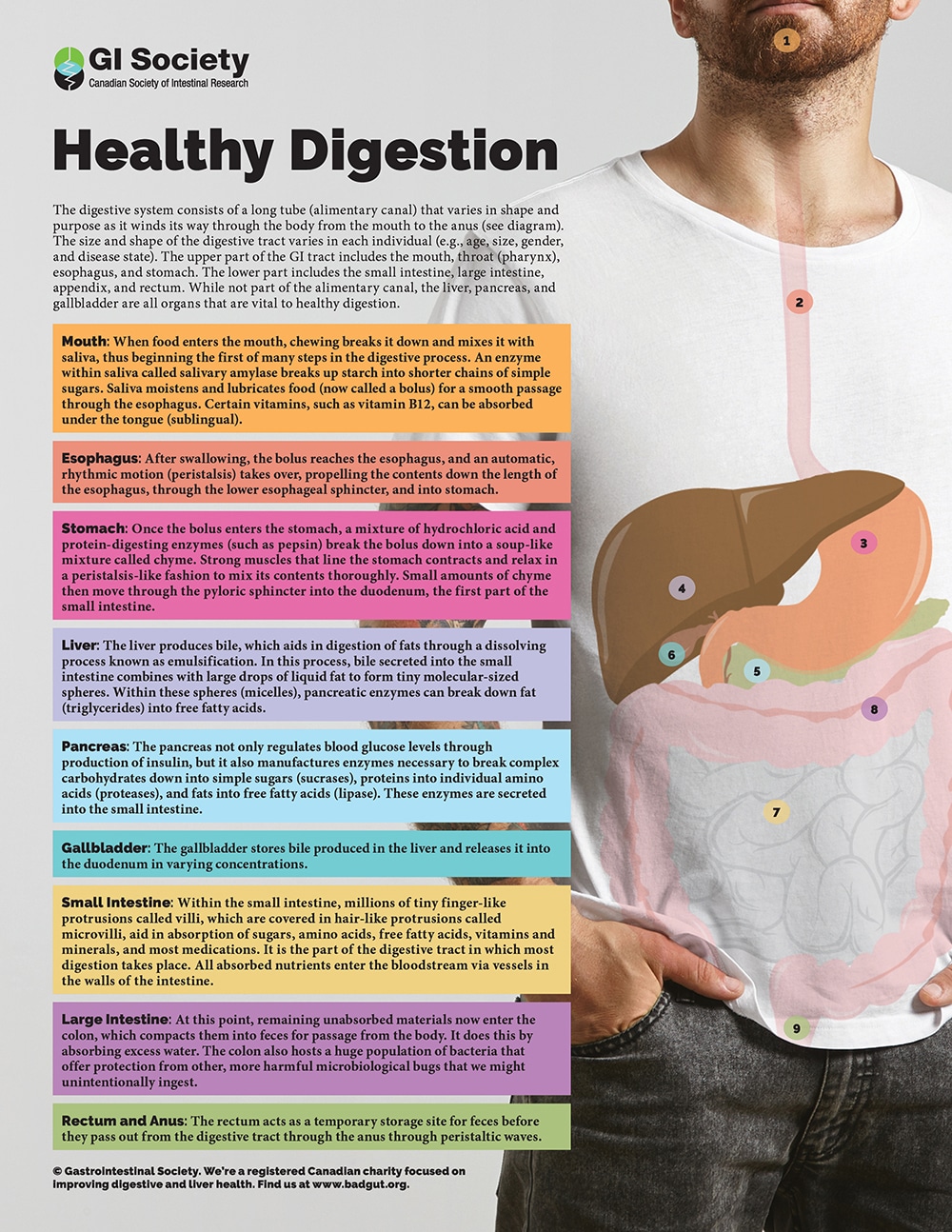Healthy Digestion
Click here for a PDF of this infograph to learn about healthy digestion.
 The digestive system consists of a long tube (alimentary canal) that varies in shape and purpose as it winds its way through the body from the mouth to the anus. The size and shape of the digestive tract varies in each individual (e.g., age, size, gender, and disease state).
The digestive system consists of a long tube (alimentary canal) that varies in shape and purpose as it winds its way through the body from the mouth to the anus. The size and shape of the digestive tract varies in each individual (e.g., age, size, gender, and disease state).
The upper part of the GI tract includes the mouth, throat (pharynx), esophagus, and stomach. The lower part includes the small intestine, large intestine, appendix, and rectum. While not part of the alimentary canal, the liver, pancreas, and gallbladder are all organs that are vital to healthy digestion.
Mouth
When food enters the mouth, chewing breaks it down and mixes it with saliva, thus beginning the first of many steps in the digestive process. An enzyme within saliva called salivary amylase breaks up starch into shorter chains of simple sugars. Saliva moistens and lubricates food (now called a bolus) for a smooth passage through the esophagus. Certain vitamins, such as vitamin B12, can be absorbed under the tongue (sublingual).
Esophagus
After swallowing, the bolus reaches the esophagus, and an automatic, rhythmic motion (peristalsis) takes over, propelling the contents down the length of the esophagus, through the lower esophageal sphincter, and into stomach.
Stomach
Once the bolus enters the stomach, a mixture of hydrochloric acid and protein-digesting enzymes (such as pepsin) break the bolus down into a soup-like mixture called chyme. Strong muscles that line the stomach contract and relax in a peristalsis-like fashion to mix its contents thoroughly. Small amounts of chyme then move through the pyloric sphincter into the duodenum, the first part of the small intestine.
Liver
The liver produces bile, which aids in digestion of fats through a dissolving process known as emulsification. In this process, bile secreted into the small intestine combines with large drops of liquid fat to form tiny molecular-sized spheres. Within these spheres (micelles), pancreatic enzymes can break down fat (triglycerides) into free fatty acids.
Gallbladder
The gallbladder stores bile produced in the liver and releases it into the duodenum in varying concentrations, as needed.
Pancreas
The pancreas not only regulates blood glucose levels through production of insulin, but it also manufactures enzymes necessary to break complex carbohydrates down into simple sugars (sucrases), proteins into individual amino acids (proteases), and fats into free fatty acids (lipase). These enzymes are secreted into the small intestine.
Small Intestine
Within the small intestine, millions of tiny finger-like protrusions called villi, which are covered in hair-like protrusions called microvilli, aid in absorption of sugars, amino acids, free fatty acids, vitamins and minerals, and most medications. It is the part of the digestive tract in which most digestion takes place. All absorbed nutrients enter the bloodstream via vessels in the walls of the intestine.
Large Intestine
At this point, remaining unabsorbed materials now enter the colon, which compacts them into feces for passage from the body. It does this by absorbing excess water. The colon also hosts a huge population of bacteria that offer protection from other, more harmful microbiological ‘bugs’ that we might unintentionally ingest.
Rectum and Anus
The rectum acts as a temporary storage site for feces before they pass out from the digestive tract via the anus through peristaltic waves.
Want to learn more about digestion?
We have several related articles that may be helpful:
